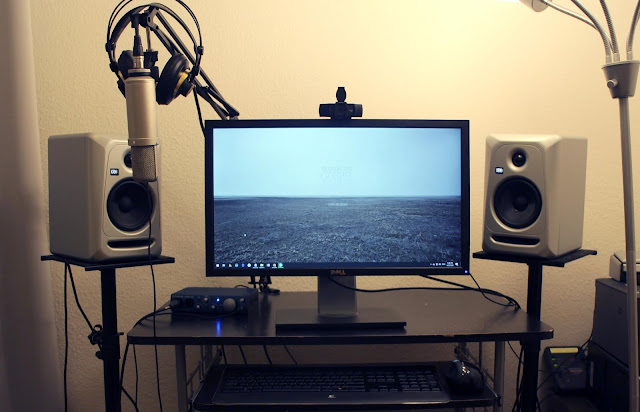How to Create a Virtual Choir
When I tried to figure out how to make a virtual choir, I couldn’t find much specific, recent guidance. And people have been asking how we made this virtual choir.
So maybe I can save you a little time/thought. Here’s how to make a virtual choir like we did. You might not do everything the same way we did. (I wouldn't be surprised if it took about 60-80 hours, not counting people's rehearsal/recording time.) So take what’s helpful, and discard the rest.
Stage 1: Prepare so people can submit coordinated videos
1. Get permission
I asked for permission from Andrew Peterson (the main songwriter).2. Get/create a choir arrangement
I wrote a choir arrangement in Logic Pro X (my arrangement is basically a combination of the Sing! conference version and Chris Tomlin's version), exported it to Sibelius, and formatted it so it could be shared as sheet music.
I created the following scores:
- Full choir
- Soprano (High)
- Soprano (Low)
- Alto
- Tenor
- Bass
3. Create audio guide tracks
I recorded an audio guide track in Logic Pro X so that people could sing along to it. On the guide track, I added specific times for people to hit "record" and to clap, so that we could line up the audio and video more easily later. (It won't provide for exact alignment, but it'll get you in the ballpark.)
This audio track included the following:
- Instruments
- Main vocals
- Choir harmonies (so that people who can’t read music can sing the parts more easily. (This is easier if you have a male and female who can record guide tracks for those respective parts. I just had myself, so the female parts didn't sound that great.)
I created several audio tracks:
- Full choir
- Bass
- Audio with Guide Vocals (with Melody)
- Audio with Guide Vocals (no Melody)
- Audio with Guide Piano (with Melody)
- Audio with Guide Piano (no Melody)
- Tenor
- Audio with Guide Vocals (with Melody)
- Audio with Guide Vocals (no Melody)
- Audio with Guide Piano (with Melody)
- Audio with Guide Piano (no Melody)
- Alto
- Audio with Guide Vocals (with Melody)
- Audio with Guide Vocals (no Melody)
- Audio with Guide Piano (with Melody)
- Audio with Guide Piano (no Melody)
- Soprano (Low)
- Audio with Guide Vocals (with Melody)
- Audio with Guide Vocals (no Melody)
- Audio with Guide Piano (with Melody)
- Audio with Guide Piano (no Melody)
- Soprano (High)
- Audio with Guide Vocals (with Melody)
- Audio with Guide Vocals (no Melody)
- Audio with Guide Piano (with Melody)
- Audio with Guide Piano (no Melody)
4. Create conductor videos
I recorded conductor videos so that people would know when to cut off notes.
I did this by recording one conductor video, and then I combined the same video with different audio parts.
This way, I created several videos with conducting:
- Full choir
- Soprano (High) + Melody
- Soprano (High) Alone
- Soprano (Low) + Melody
- Soprano (Low) Alone
- Tenor + Melody
- Tenor Alone
- Bass + Melody
- Bass Alone
5. Create a website to give instructions
I created a free website to give people instructions to learn the song and record it. I used other virtual choirs as inspiration for my instructions. I posted all of the above (sheet music, audio with individual parts/the whole choir, video with individual parts/the whole choir) to this site.
I could have used a Google Doc with hyperlinks, but I chose a website, since it would let me embed YouTube pages.
I could have used a Google Doc with hyperlinks, but I chose a website, since it would let me embed YouTube pages.
I created the website through Strikingly, because it let me create a free website easily, with relatively subtle advertising.
6. Create a way to submit videos
I created a Google Form so that people could upload their files. (I used my church’s Google Drive account, since it has "unlimited" space.) I set an upload limit of 1 GB per file, with a total limit of 1 TB for all files.
If you have a small, trusted group, you could instead share a Google Photos folder or upload videos as unlisted videos in a shared YouTube/Vimeo account. But we chose to use a Google Form, so that we could get native files, without Google’s encoding.
Stage 2: Get videos
7. Ask for videos
I asked people to submit videos by a set deadline, advertising this on my church’s private Facebook group.
Some people from outside my church asked to join, and I loved their enthusiasm! But I turned them down, since this was a replacement for my church’s Easter choir, and it would be weird for our church to have “random strangers” join our Easter choir.
8. Receive videos
We received submissions through the Google Form. After the submission deadline, I asked specific people for a few additional submissions, to round out certain parts.
Stage 3: Put the videos together
9. Create the arrangement
I chose who would sing melody for which parts. I switched the lead singers often, so more people could participate.
10. Audio editing
I edited, mixed, and mastered the audio in Logic Pro X.
11. Video editing
My friend used Adobe Premiere Pro to edit the videos and combine them with the audio.
Here's basically how he did it.


Comments
Post a Comment